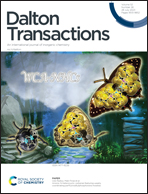Oxidative dissolution mechanism of both undoped and Gd2O3-doped UO2(s) at alkaline to hyperalkaline pH†
Abstract
The dissolution rates of unirradiated UO2 and unirradiated UO2 doped with Gd2O3 were determined as a function of pH using flow-through experiments in the presence of O2(g) and bicarbonate. The dissolution rate of non-doped UO2 was very low under hyperalkaline conditions (pH 12–13) whereas it increased drastically as the pH decreased to 9. The dissolution of non-doped UO2 in the pH range of 9–13 was consistent with the oxidative dissolution mechanism already described for UO2 dissolution in the presence of bicarbonate and oxygen. XPS analysis performed on the solid after dissolution experiments at pH 10 and 13 supported the bicarbonate effect to complex UO22+ and accelerate dissolution. Moreover, UO2 doped with Gd2O3 (5 wt% and 10 wt%) showed dissolution rates as low as non-doped UO2 under hyperalkaline conditions, which were maintained throughout the pH range studied (9–13). No substantial differences in the dissolution rates between these two doping levels were found. XPS analysis evidenced a similar surface composition both at pH 10 and 13, with U(V) being the dominant oxidation state. The low dissolution rates were assumed to be a consequence of the gadolinium capacity to retard the oxidation of U(V) to U(VI). The slight increase in dissolution rates observed in the hyperalkaline region was attributed to a shift in the oxidative dissolution mechanism, in which the presence of OH− promotes the formation of soluble uranyl hydroxo complexes.



 Please wait while we load your content...
Please wait while we load your content...